|
|
 |
Fiche d'espèce de Copépode |
|
|
Calanoida ( Ordre ) |
|
|
|
Calanoidea ( Superfamille ) |
|
|
|
Megacalanidae ( Famille ) |
|
|
|
Elenacalanus ( Genre ) |
|
|
| |
Elenacalanus princeps (Brady, 1883) (F,M) | |
| | | | | | | Syn.: | Calanus princeps Brady, 1883 (p.36, figs.F); Giesbrecht, 1892 (p.300); Giesbrecht & Schmeil, 1898 (p.52);
Heterocalanus medius Wolfenden, 1906 (p.27); 1911 (p.201, figs.F);
Bathycalanus rigidus Sars, 1920 c (p.2); 1924/1925 (p.19, figs.F); Rose, 1929 (p.9, Descr.M, figs.M); Jespersen, 1934 (p.46); Wilson, 1936 c (p.90); Wilson, 1942 a (p.172);
Megacalanus princeps : Pearson, 1906 (p.6); Farran, 1908 b (p.21, Rem.); Wilson, 1942 a (p.193); C.B. Wilson, 1950 (p.262); Fagetti, 1962 (p.8); Morioka, 1972 a (p.314); Lozano Soldevilla & al., 1988 (p.57);
Macrocalanus princeps : With, 1915 (p.37, figs.F,M);
Bathycalanus princeps : Farran, 1939 (p.360, Rem.); Jespersen, 1940 (p.10); Vervoort, 1946 (p.70, Rem.); Farran & Vervoort, 1951 a (n°33, p.3, figs.F); Vervoort, 1963 b (p.87, Rem.); Grice & Hulsemann, 1967 (p.13); Michel, 1994 (p.186, Rem.); Bradford-Grieve & al., 1999 (p.877, 906, figs.F); Blanco-Bercial & al., 2011 (p.103, Table 1, Biol. mol, phylogeny); Ref. compl. : Grice & Hulsemann, 1967 (p.13), 1968 (tab.2); Björnberg, 1973 (p.303); Harding, 1974 (p.141, tab.2, gut contents); Childress, 1975 (p.787, respiratory rate); Deevey & Brooks, 1977 (p.256, Table 2, Station "S"); Razouls & al., 2000 (p.343, tab. 5, Appendix); Holmes, 2001 (p.35).
Nota: Synonymies after Bradford-Grieve & al. (2017, p.132) underline. (See in remarks, p.139 concerning doubtful identifications. | | | | Ref.: | | | Bradford-Grieve & al., 2017 (p.132, Descr. F,M, figs.F,M, Rem., fig.114: depth range) |  issued from : R.N. Wolfenden in Die Marinen Copepoden der Deutschen Südpolar-Expedition 1901-1903, 1911. [Pl.XL, Figs.1-5]. As Heterocalanus princeps Female: 1, habitus (lateral); 2-4, forehead (lateral, dorsolateral and dorsal, respectively); 5, P1. Nota after Bradford-Grieve & al. (1999, p.906): Female and Male with crest on dorsal forehead.
|
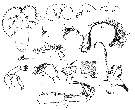 issued from : M. Rose in Result. Camp. Scient. Prince Albert Ier, Monaco, 1929, 78. [Pl. I, Figs.1]. As Bathycalanus rigidusMale (from 38°30'N, 34°40'W): D, habitus (dorsal); F, forehead with ocular patches (dorsal); A1; Co, dorsal medial process between the 1st and 2nd thoracic segments (lateral); R1, forehead with rostrum (lateral); R2, idem (frontal view); A1 B, proximal segments of the no geniculated A1; A1 prehensile A1; A2; Md (cutting edge); P, Md (mandibular palp); detail of mandibular palp); Mx1 (as Mx); Mxp (as Mxp2). Nota: - Head without crest, nor point forhead. - Rostrum with 2 blunted points, ventrally. - Posterior corners of 5th pedigerous somite rounded. - Dorsally, between the cephalon and the 1st pedigerous somite a strong and curved apophyse backward and into a deep hollow, relatively slightly prominent in lateral view. - A1 25-segmented, 8th and 9th segments fused, passing beyond the caudal rami. Right and left antennula asymmetrical, the left ordinary, 3rd segment bearing a very long seta not plumose. - Md gnathobase and masticatory edge strong with sharp teeth.
|
 issued from : M. Rose in Result. Camp. Scient. Prince Albert Ier, Monaco, 1929, 78. [Pl. I, Figs.1]. As Bathycalanus rigidus.Male: G, double articulation of the prehensile A1; Ab, urosome (lateral right side). Nota:
- Abdomen 5-segmented, 2nd abdominal segment swollen, more longer than others;
- Caudal rami short, hirizontally divergent, 5 setae each ramus and on an horizontal line.
- Urosome about 1/5 the body length.
Anal segment very reducted.
Right A14 with an prehensile organ, median segments swollen, 2 geniculate articulations
|
 issued from : M. Rose in Result. Camp. Scient. Prince Albert Ier, Monaco, 1929, 78. [Pl. I, Figs.1]. As Bathycalanus rigidus. Male: Mx2 (as Mxp1); P1 to P5; P5 g, left P5; P5 Re dr, exopod of right P5; Re2 g, 2nd exopodite of left P5; C, detail of the inner element of the 2nd exopodite segment of left P5. Nota: P5 slightly asymmetrical, the left leg different, with a size more weak and the of the structure of the 2nd exopodal segment. On the left leg, basis bearing 2 spines on the outer margin, on the right leg only a tiny hair . On the right ramus, inner edges of the 3 article naked, hairies on the left ramus.
|
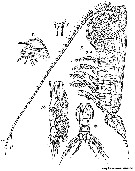 Issued from: G.O. Sars in Résult. Camp. Scient. Prince Albert I, 69, pls.1-127 (1924). [Pl.V, figs. 7, 8, 9, 12, 15]. As Bathycalanus rigidus. Female: 7, habitus (lateral); 8, forehead (lateral); 9, rostrum (frontal view); 12, P1; 15, urosome (dorsal). Nota: Rostrum with cylindrical round-ended filaments. P1 lacking outer spine on 1st and 2nd exopodal segments.
|
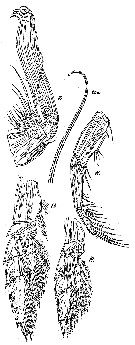 Issued from: G.O. Sars in Résult. Camp. Scient. Prince Albert I, 69, pls.1-127 (1924). [Pl.V, figs. 10, 10a, 11, 13, 14]. As Bathycalanus rigidus. Female: 10, Mx2; 10a, distal portion of a seta of Mx2; 11, Mxp; 13, P3; 14, P5. Nota: Distal setae of Mx2 elongate, densely spinulose, with curved tips.
|
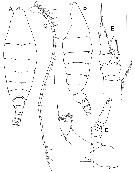 Issued from : J.M. Bradford-Grieve, L. Blanco-Bercial & G.A. Boxshall in Zootaxa, 2017, 4229 (1). [p.133, Fig.87]. Female (from 46.617°S, 75.800°W): A-B, habitus (dorsal and lateral, respectively); C, A1; D, A2; E, P1 (posterior view). Scale bars: 1.0 mm (A-C, E); 0.1 mm (D). Nota: - Anterior margin of head with low crest (in dorsal and lateral views); - Posterior corners of pediger 5 short and rounded. - Genital double-somite symmetrical in dorsal view, bulbous, wider than long; - A1 26-segmented (segments 8 and 9 imperfectly separate), extending beyond caudal rami by 6 segments. Ancestral segments I, II, III and V with dorsal surface hair sensillum and adjacent macula cribrosa, ancestral segment IV has only hair sensillum. - A2 ancestral exopodal segment IV without seta.
|
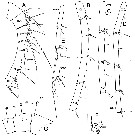 Issued from : J.M. Bradford-Grieve, L. Blanco-Bercial & G.A. Boxshall in Zootaxa, 2017, 4229 (1). [p.134, Fig.88]. Female: A, A1 ancestral segments I-XI; ; B, A1 ancestral segments XII-XVI; C, A1 ancestral segments XVII-XIX; D, A1 ancestral segments XX-XXIII; E, A1 ancestral segments XXIV-XXVIII; F, detail of ancestral segment XXVIII; G, ancestral segments I-V dorsal surface showing distribution of hair sensilla (hs) and maculae cribrosae (mc). Scale bars1.0 mm (A-E); 0.1 mmF, G).
|
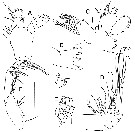 Issued from : J.M. Bradford-Grieve, L. Blanco-Bercial & G.A. Boxshall in Zootaxa, 2017, 4229 (1). [p.135, Fig.89]. Female: A, Md palp; B, Md gnathobase; C, Mx1; D, Mx2; E, endopod of Mx2; F, Mxp; G, terminal part of Mxp. Scale bars: 1.0 mm (D, F); 0.1 mm on remaining figures. Nota: - Mx1 basal endites 1 and 2 with 2 and 2 setae, respectively; endopd wegments with 1-2, 0-1,4+1 small anterior surface setae; basal exite without seta, epipodite with 7 long and 2 vestigial setae. - Mxp syncoxal endites with 1, 2 (1 vestigial), 4, 4 (1 vestigial) setae, longest seta on endite 4 extending as far as distal border of basis; endopod seglents 3-6 with 1, 1, 1 (no outer border seta but 1 macula cribrosa), 3 terminal setae (2 large and 1 small, no seta on outer border, respectively.
|
 Issued from : J.M. Bradford-Grieve, L. Blanco-Bercial & G.A. Boxshall in Zootaxa, 2017, 4229 (1). [p.136, Fig.90]. Female: A, P2 (anterior view); P3 (anterior view); C, P4 (anterior view); D, P5 (anterior view). Scale bar; 1.0 mm on all figures.
|
 Issued from : J.M. Bradford-Grieve, L. Blanco-Bercial & G.A. Boxshall in Zootaxa, 2017, 4229 (1). [p.137, Fig.91]. Male (57.7°S, 138.1°): A-B, habitus (dorsal and lateral, respectively); C, detail of rostrum (lateral); D, right A1; E, Md palp; F, distal part of Md gnathobase; G, P1 (anterior view). Male (from 60°N, 20°W): H, P5 (posterior view); Specialised seta on left exopodal segment 2 of North Atlantic specimens: I, K (from 60°N, 20°W); M from 53°N, 20°W; N from 40°N, 20°W; J, L from 44°N, 13'W.Scale bars: 1.0 mm (A-D, G, H); 0.1 mm on remaining figures. Nota: - Anterior margin of head in dorsal and lateral views rounded, without crest.. - Rostrum ventrally-directed, bluntly tapering - Md basis with 3 setae; endopodal segment 2 with 9 setae. - Urosome of 5 free somites. - P5 slightly asymmetrical. Right exopodal segment 3 with tuft of proximal setules on inner border whereas left exopodal segment 3 inner border densely setulose. Exopodal segment 2 on left variable with characterised specialised inner distal seta made of 2 parts: basal part and setulose lash; basal part usually rectangular, distally setulose (in some specimens base slightly drawn out) and with setules at base of lash; setulose lash arising from proximal border of basal part. Left exopodal segment 3 carrying 1 terminal, 1 inner (at about distal 1/4) and 1 outer border spine (at distal 1/3rd; right exopodal segment 3 with 1 termial spine, 1 inner and 1 outer border spine positioned opposite each other. Macula cribrosa present on each basis and exopod segments 1-3.
|
 Issued from : J.M. Bradford-Grieve, L. Blanco-Bercial & G.A. Boxshall in Zootaxa, 2017, 4229 (1). [p.137, Fig.91]. Male (from 57.7°S, 138.1°W): A, left A1 ancestral segments I-XIV; B, left A1 ancestral segments XV-XX; C, left A1 ancestral segmentsXXI-XXIV; D, right A1 ancestral segments I-XII (arrow indicates clavate seta); E, right A1 ancestral segments XIII-XIX; F, right A1 ancestral segments XX-XXVIII; G, right A1 detail segment XXVIII; H, clavate seta on segment XI of right A1. Scale bats: 1.0 mm (A-F); 0.1 mm (G, H). Nota: A1 asymmetrically developed, geniculate on right; A1 ancestral segments I and II fused. On right side, segments XVI to XIX with narrow proximal anterior border ridge; fused gripping element on segment XIX extending distally well beyond insertion of aesthetasc; ancestral segment XX curved on shorter radius than in E. eltaninae; proximal fused gripping element of fused segments XXI-XXIII overlapping 2nd fused gripping element by about 40% of its length and gripping element 2 extending distally beyond base of small seta of incorporated segment XXIII. Left A1 segments XXV-XXVIII broken off.
|
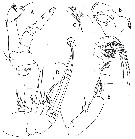 Issued from : J.M. Bradford-Grieve, L. Blanco-Bercial & G.A. Boxshall in Zootaxa, 2017, 4229 (1). [p.139, Fig.93]. Male (from 57.7°S, 138.1°W): A, A2; B, Mx1; C, Mx1 praecoxal arthrite; D, Mx2; E, Mxp. Scale bars: 0.1 mm (A-E). - Nota: - A2, Md, Mx1, Mxp, P1 to P4 as in female, although some setae on mouthparts may be reduced in size and number relative to female. - A2 ancestral endopod segments I-IV without setae. - Mx1 praecoxal arthrite with about 10 reduced setae, apparently none on posterior surf/0, 0, 4 setae; basal endites 1 and 2 with 2 and 0 setae, respectively; endopod segments with 1/0, 0, 4 setae; exopod with 11 setae; basal exite without seta, epipodite with 7 long setae, proximal 2 setae absent. - Mx2 as in female but setae weakly developed; 2 setae of basal endite and setae of endopod segments 1-4 long, distally weak and narrow therefore not holding their distal curl, lined distally with very dense, fine spinules. - Mxp syncoxa endites with 1, 2 (1 vestigial), 4, 3 setae, respectively, longest seta on endite 4 extending to distal seta of basis; endopod segments 3-6 with 1, 1, 1 (noouter border seta), 2 large setae and 1 short seta, respectively.
|
 Issued from : J.M. Bradford-Grieve, L. Blanco-Bercial & G.A. Boxshall in Zootaxa, 2017, 4229 (1). [p.91, Table 11]. Morphological characters after identification key of Elenacalanus females and males. Compare to other species of genus. Main characters identification after species key : 1 - Head with crest in female, rounded in male: male P5 right exopod segment 3 inner border with patch of proximal setules.
|
 Issued from M. Rose in Résult. Camp. scient. Prince Albert I, 1929, 78, p.9. Description du mâle de Bathycalanus rigidus [ = Elenacalanus princeps (Brady, 1883)] échantillonné à la station 3526 lors de la campagne de 1913.
|
 Issued from M. Rose in Résult. Camp. scient. Prince Albert I, 1929, 78, p.10. Suite de la description du mâle de Bathycalanus rigidus [ = Elenacalanus princeps (Brady, 1883)] échantillonné à la station 3526 lors de la campagne de 1913.
|
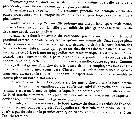 Issued from M. Rose in Résult. Camp. scient. Prince Albert I, 1929, 78, p.11. Suite de la description du mâle de Bathycalanus rigidus [ = Elenacalanus princeps (Brady, 1883)] échantillonné à la station 3526 lors de la campagne de 1913.
| | | | | NZ: | 10 + 3 douteuses | | |
|
Carte de distribution de Elenacalanus princeps par zones géographiques
|
| | | | | | | | | | | | | Loc: | | | Antarct. (Drake Passage, SW & S Atlant., Indian: continent, S & SE Pacif., sub-Antarct. (SE Pacif.), ? G. of Guinea, ? Cape Verde Is., ? Canary Is., Azores, Sargasso Sea, Station "S" (32°10'N, 64°30'W), Bermuda, off E Cape Cod, off Woods Hole , Strait of Davis, S & W Ireland, Faroe Is., ? North Sea, SW Indian, ? off SE & S Hokkaido, ? S California, ?off SE Easter Is., Juan Fernandez Is., S Chile
Type locality: 38°34'N, 72°10'W.
Some localisations need confirmation (indicate by ? on the chart. See after restricted synonymies in Bradford-Grieve & al., 2017, p.141, fig.94). | | | | N: | 23 | | | | Lg.: | | | (1) F: 11; (7) F: 13,5; (10) F: 10,75; (49) F: 13,2-11,8; (787) F: 13-10,5; {F: 10,50-13,50}
After Bradford-Grieve & al. (2017, p.132, 135): (1316) F: 11,5-13,4 (mean = 12,5); M: 8,9; {F: 11,5-13,4; M: 8,9} | | | | Rem.: | Meso-Bathupelagic. Sampling depth (Antarct., sub-Antarct.) : 3000 m. Sampling in vertical tow 2000-1000 m (Harding, 1974).
Voir aussi les remarques en anglais | | | Dernière mise à jour : 10/08/2018 | |
|
|
 Toute utilisation de ce site pour une publication sera mentionnée avec la référence suivante : Toute utilisation de ce site pour une publication sera mentionnée avec la référence suivante :
Razouls C., Desreumaux N., Kouwenberg J. et de Bovée F., 2005-2026. - Biodiversité des Copépodes planctoniques marins (morphologie, répartition géographique et données biologiques). Sorbonne Université, CNRS. Disponible sur http://copepodes.obs-banyuls.fr [Accédé le 07 janvier 2026] © copyright 2005-2026 Sorbonne Université, CNRS
|
|
 |
 |



















